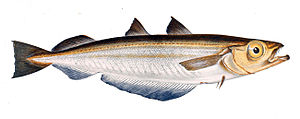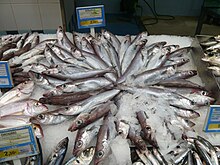Blue whiting
| Blue whiting | ||||||||||||
|---|---|---|---|---|---|---|---|---|---|---|---|---|

Blue whiting ( Micromesistius poutassou ) |
||||||||||||
| Systematics | ||||||||||||
|
||||||||||||
| Scientific name | ||||||||||||
| Micromesistius poutassou | ||||||||||||
| ( Risso , 1827) |
The Blue whiting ( Micromesistius poutassou ) is a species of the family of cod . It becomes 40 to 50 cm long and occurs in the northern Atlantic . Its exact distribution area extends in the northeastern Atlantic from the Barents Sea , along the Norwegian coast to the coast of northwestern Africa to Cape Bojador . It also occurs in the western Mediterranean . It was first observed in the German Bight in March 1964. It lives in the western Atlantic from the coast of southern Greenland to the coast of the northeastern USA .
features
Blue whiting is gray-blue on the upper side, the underside is more whitish. The distance between the three dorsal fins is long, the distance between the second and the third is longer than the base of the first. There is sometimes a black spot at the base of the pectoral fins . The lower jaw protrudes slightly. A goatee is missing. The mouth and gill cavities are black. The lateral line organ is continuous.
Fins formula : dorsal 0 / 24–28, anal 33–39, ventral I / 2–5, pectoral 11–25
Way of life
Blue whiting live as pelagic schooling fish at depths of 100 to 1000 meters. They mainly live on continental slopes at depths of 150 to 400 meters, but also go into the open sea. They feed on small crustaceans , small fish and cephalopods and take part in the daily vertical migrations of their prey . While they tend to be near the seabed during the day, they rise closer to the water surface at night. In Norway , Iceland , and west of the British Isles, they spawn from March to April. The females lay 6,000 to 150,000 pelagic eggs, each one millimeter in diameter. The larvae hatch after about a week, depending on the water temperature, and are then about three millimeters long. After the spawning season, the swarms move to their feeding grounds to the north. In the first year of life they reach a length of 16 cm, in the fifth they are about 25 to 30 cm long. They become sexually mature at around 2 to 7 years of age.
use
Like other schooling fish, blue whiting is usually caught with trawls . The edible fish is heavily fished , marketed both fresh and frozen and processed into fish fingers , but also into fish oil and fish meal . In 2001 1.8 million tonnes of blue whiting were caught.
Individual evidence
- ↑ Jürgen Flüchter, Harald Rosenthal: Observations on the occurrence and spawning of the blue whiting (Micromesistius poutassou Risso) in the German Bight . In: Helgoland scientific marine studies . tape 12 , no. 1-2 , July 1965, pp. 149-155 , doi : 10.1007 / BF01612097 .
- ↑ a b c d Blue Whiting on Fishbase.org (English)
- ↑ Description at FAO
- ↑ Sea animals are not rubbish! (PDF) WWF Germany , December 13, 2008, p. 6 , accessed on April 29, 2016 .
- ↑ WWF Germany : Study: Fish farms contribute to overfishing . 2003.
literature
- Bent J. Muus, Jørgen G. Nielsen: The marine fish of Europe in the North Sea, Baltic Sea and Atlantic. Kosmos, Stuttgart 1999, ISBN 3-440-07804-3 .
